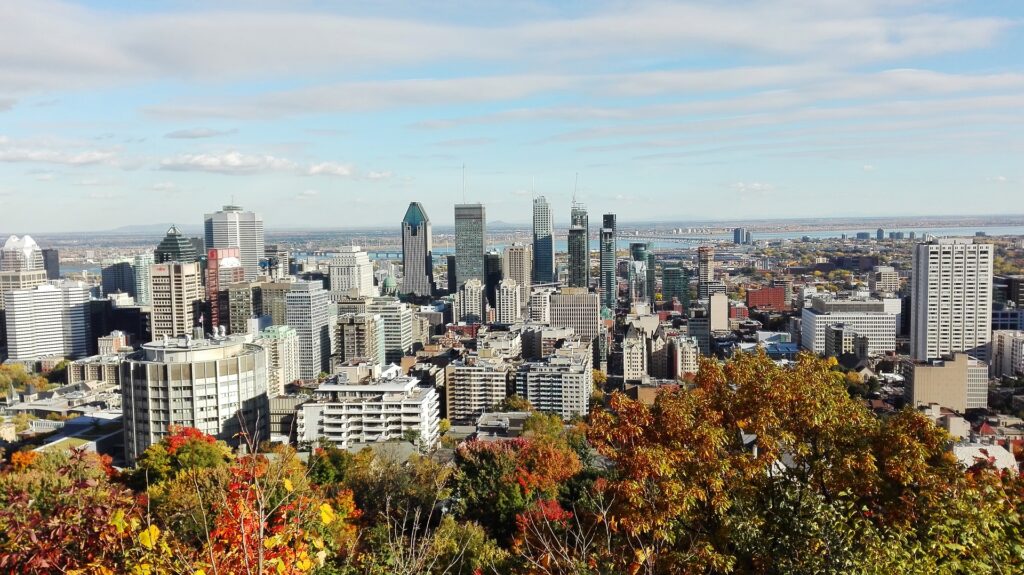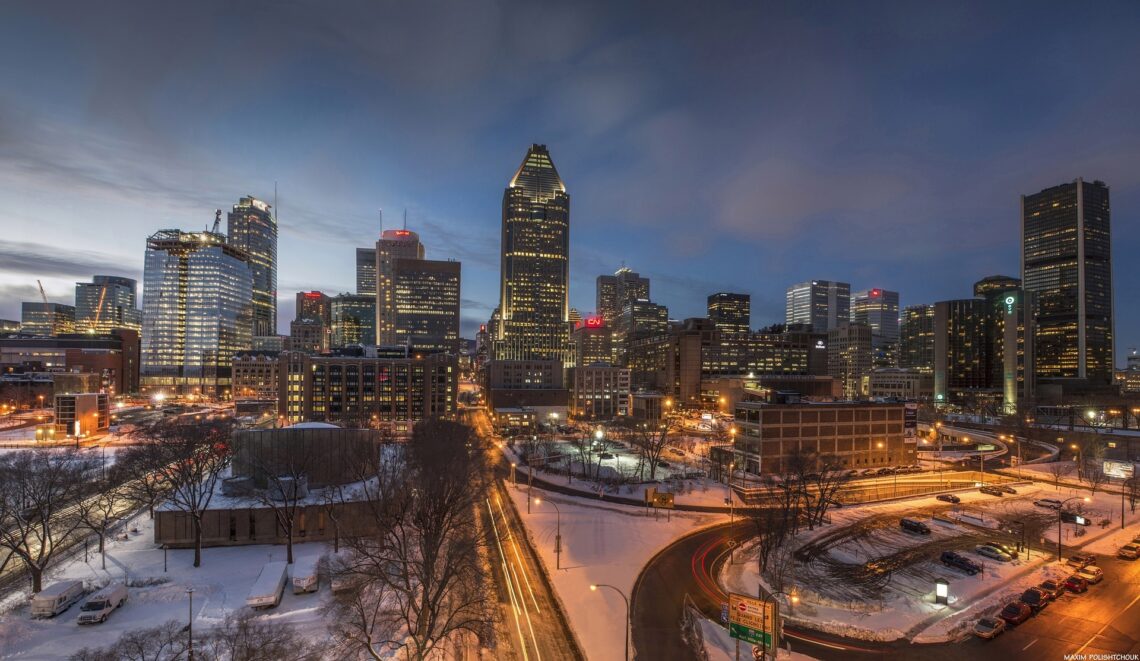Montreal, located on an island in the Saint Lawrence River, experiences a humid continental climate with four distinct seasons. Winters are cold with heavy snowfall, while summers are warm and ideal for outdoor activities, making it a popular time to visit.
Spring in Montreal (March to May)
Spring in Montreal can be unpredictable. March often brings late snowstorms, while temperatures begin to rise in April, gradually melting the snow. Although visitor numbers start increasing, it can still feel chilly even into May.
Recommended Clothing:
Spring weather can change rapidly, from lingering snowstorms to warm afternoons. It’s best to dress in layers, and bring warm clothing, a coat, and waterproof, sturdy footwear.
March
March marks the slow retreat of winter. Average temperatures hover around -2°C (28°F), and daytime highs occasionally rise above freezing. Melting snow can make the streets slushy, and late-season snowstorms are still possible.
April
April brings true signs of spring. The average temperature reaches around 7°C (45°F), with chilly mornings and evenings but milder afternoons. Snow turns into rain, and parks begin to show fresh greenery. However, sudden cold snaps and showers are still common.
May
In May, spring is in full bloom. Average temperatures rise to about 14°C (57°F), and the city comes alive with flowers, outdoor festivals, and pleasant weather. Mornings and evenings can still be cool, so it’s wise to pack a light jacket.
Summer in Montreal (June to August)
Many visitors look forward to Montreal’s summer after the long winter, but be prepared — it can get hot and humid. Rain is fairly common, with July experiencing about 11 rainy days.
Recommended Clothing:
Opt for breathable, lightweight clothing for daytime, but bring a light cardigan or jacket for cooler evenings.
June
June ushers in early summer vibes with average highs around 20°C (68°F), often reaching 25°C (77°F) during the day. Parks and riverbanks are bustling with picnics and festivals. Occasional showers are likely, so keep an umbrella handy.
July
July is one of the hottest months, with average highs of 22–23°C (72–73°F) and peak daytime temperatures sometimes exceeding 30°C (86°F). Humidity levels are high, making it feel even warmer. Major outdoor events like the International Jazz Festival fill the city with energy.
August
August continues with hot and humid weather, with an average high around 21°C (70°F). Toward the end of the month, temperatures start to cool slightly. Be prepared for sudden thunderstorms, but vibrant summer festivals still keep the city lively.

Fall in Montreal (September to November)
Fall is one of the best times to enjoy Montreal’s pleasant weather. It’s neither too hot nor too humid, and temperatures are ideal for outdoor activities. October’s average high is around 13°C (55°F), but by November, it gets colder, and the first snowfalls may occur.
Recommended Clothing:
Prepare for a variety of conditions — from sunny days to sudden snow. Long-sleeved shirts, sweaters, jackets, and long pants are essential. A lightweight down jacket and waterproof walking shoes are also recommended.
September
September marks the beginning of fall. Average temperatures hover around 16°C (61°F), with warm afternoons and cooler mornings and evenings. The city starts to glow with beautiful fall foliage — perfect for scenic walks and drives.
October
October is peak fall season. Average temperatures drop to about 10°C (50°F), and Montreal’s parks and streets are ablaze with colorful autumn leaves. Pack warm clothing, as temperatures can dip quickly, especially in the evenings. Halloween festivities add a lively atmosphere to the city.
November
November signals the transition to winter. With an average temperature of around 3°C (37°F), it’s chilly, and rain or sleet is common. Days grow shorter, and the wintery mood begins to set in. Occasional early snowfalls can occur, so it’s a good time to start preparing for winter.
Winter in Montreal (December to February)
Montreal’s winters are long and can stretch into April. Snow and freezing rain typically start in December and continue through February. Even daytime highs often stay below freezing, with average lows between -9°C and -14°C (16°F to 7°F). Outdoor plans require careful preparation due to the intense cold.
Recommended Clothing:
Bundle up with a thick, warm down jacket, sweaters, thermal underwear, boots, scarves, gloves, and a cozy hat. Don’t forget sunscreen and sunglasses — sunlight reflecting off the snow can be surprisingly intense.
December
December marks the beginning of the true winter season. Average temperatures are around -4°C (25°F), and snowfalls are frequent. With Christmas approaching, the city sparkles with festive lights and decorations. Warm winter gear is essential for exploring outdoors.
January
January is the coldest month in Montreal. Average temperatures drop to -10°C (14°F) and can plunge below -20°C (-4°F) during cold snaps. Heavy snowfall covers the streets and parks, and strong winds make it feel even colder.
February
February remains very cold, with average temperatures around -8°C (18°F). Snow and ice continue to dominate, but lively events like the Fête des Neiges winter festival keep spirits high. Days slowly start to get longer, but staying warm remains a priority for outdoor adventures.
Best Time to Visit Montreal
The best time to visit Montreal is during the summer months from June to August, when the weather is warm and ideal for outdoor activities. However, this is also the peak tourist season, so hotel prices can rise — it’s best to book accommodations early. If you want to avoid the crowds, spring and fall offer mild weather and fewer tourists, making them great alternatives.
Montreal Monthly Weather Overview
| Month | Avg. High Temp (°C) | Avg. Low Temp (°C) | Precipitation (mm) | Snowfall (cm) |
| January | -5.3 | -14.0 | 77.2 | 49.5 |
| February | -3.2 | -12.2 | 62.7 | 41.2 |
| March | 2.5 | -6.5 | 69.1 | 36.2 |
| April | 11.6 | 1.2 | 82.2 | 12.9 |
| May | 18.9 | 7.9 | 81.2 | — |
| June | 23.9 | 13.2 | 87.0 | — |
| July | 26.3 | 16.1 | 89.3 | — |
| August | 25.3 | 14.8 | 94.1 | — |
| September | 20.6 | 10.3 | 83.1 | — |
| October | 13.0 | 3.8 | 91.3 | 1.8 |
| November | 5.9 | -1.7 | 96.4 | 19.0 |
| December | -1.4 | -9.3 | 86.8 | 48.9 |



